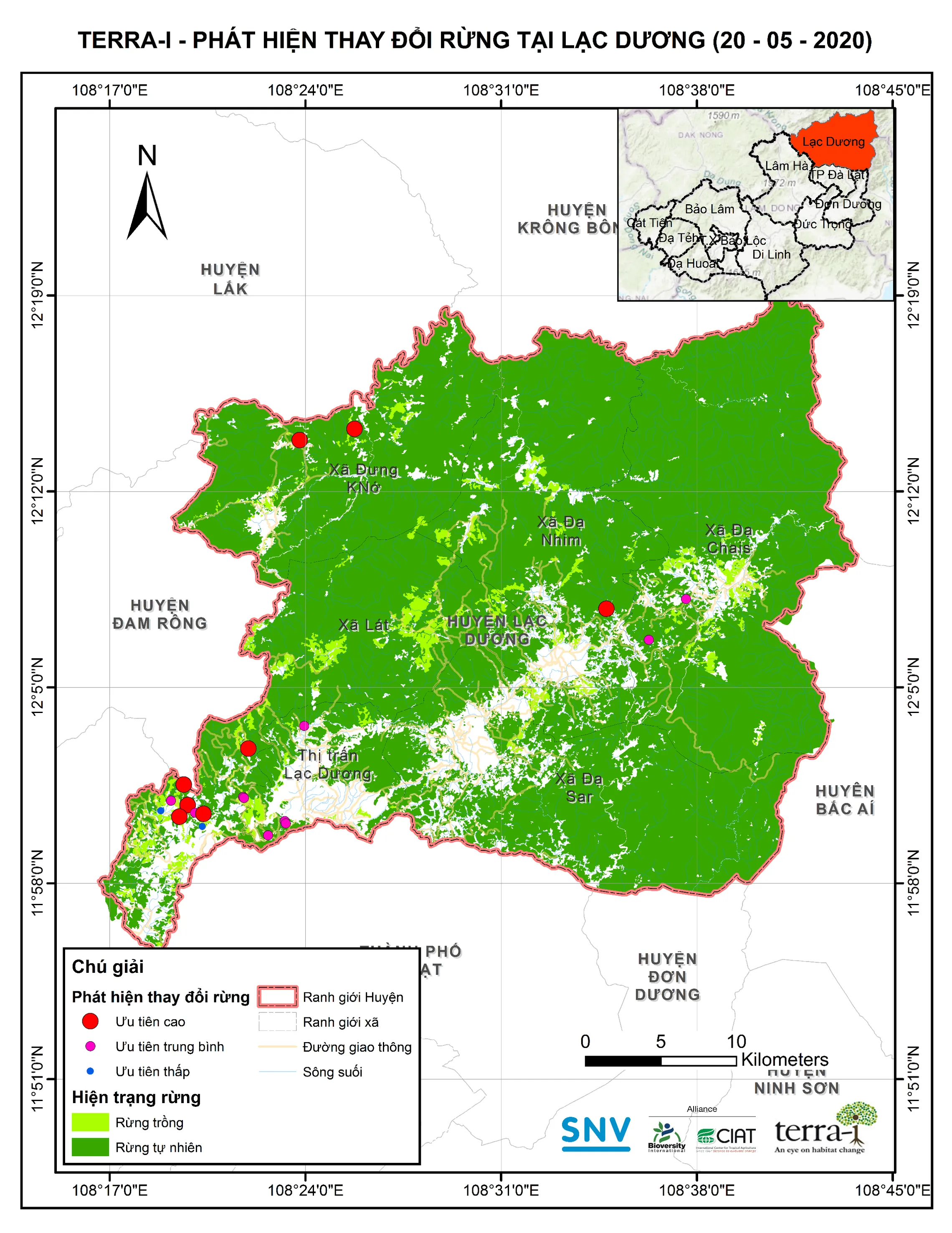CIAT organizes Terra-i training for provincial officers to monitor vegetation loss and land use change in Lam Dong Province

The Alliance of Biodiversity International and the International Center for Tropical Agriculture (CIAT) (the Alliance) conducted a training for local stakeholders on the use of Terra-i as part of the collaboration with the SNV Netherlands Development Organisation in the Coffee Agroforestry and Forest Enhancement for REDD+ (CAFÉ-REDD) Project funded by the International Climate Initiative (IKI) of the Federal Ministry for the Environment, Nature Conservation and Nuclear Safety (BMU).
The project uses Terra-i, a near real-time monitoring system for natural vegetation loss detection and land-use change in Lac Duong district, Lam Dong province to reduce deforestation and forest degradation in Lang Biang landscape. This project comes after a successful pilot of an UN-REDD supported project that used Terra-i (version 3.0) in monitoring forest conversion to coffee plantation using real-time data in Di Linh district, Lam Dong province.
As part of the capacity building for the project, the first training of provincial officers on the operation and use of Terra-i to support near real-time forest cover monitoring in Lac Duong district was held last 24 February-06 March 2020 at the Alliance Asia Hub in Hanoi. The training participants are composed of five technical officers from the Forest Protection Department (FPD) of Lam Dong province, Lac Duong district, Bi Doup Nui Ba National Park, Da Nhim Forest Management Board, and a consultant from farm mapping using drones package of Café-REDD.
The 10-day intensive training covered all the steps to operate Terra-i version 3.0—covering bases from installation, project management, satellite image download, pre-processing, multi-image analysis for detecting changes, to interpreting results. At the end of the training, the participants were able to execute the operational steps of Terra-i version 3.0 and they were able to run the system and produce change detections for a small interesting area in Lam Dong province.
Use of near-real-time data on vegetation loss
To detect near real-time vegetation loss and gain resulting from human activities, Terra-i provides information about land-use change with a frequency and spatial resolution relevant for decision-makers. The latest version (version 3.0) uses high resolution (10m) satellite images from Sentinel-1/2 and Landsat 8 datasets to detect small-scale changes at the district level. This is a major focus for further development of the Terra-i system to become more applicable to current practices and location conditions, including the integration of higher resolution imagery. Employing the latest version Terra-i fitted with customizations to meet the needs and conditions of Lac Duong district can detect vegetation loss up to 100 square meters and send alerts every 12 days. Detected forest loss areas are ranked in terms of priority: low, medium, and high, based on the size of the detections and forest origin. The alerts will help equip local forest monitoring and governance stakeholders (e.g. forest owners, local residents, community and authorities, forest protection officers, Provincial Department of Agriculture and Rural Development, etc.) with timely information on land-use change and forest loss, to implement proper and timely response.
The first batch of change detections has been released in February 2020 for Lac Duong district with time series satellite imagery dated from March 2015 to January 2020. All the data with detailed information of the detections including locations, forest cover types, forest owners, level of priority, date of detection etc. are available in the Terra-i Vietnam website.

Map of change detections for Lac Duong district
Stakeholder engagement and next steps
Mr. Hoang Van Minh from Lam Dong FPD expressed his impression as a first time Terra-i user. “This is a new experience for us. It takes time and effort to master the skills to operate the system,” he says, “However, it’s worth it as Terra-i is useful in providing timely alerts to support our daily task of monitoring forest cover change.”
The team recognized challenges that come with operating the system and discussed that participants need more time to practice and explore the scripts. The need for hardware installation has also been raised as the system requires a high performance computing system to process big data.

Intensive technical capacity building for provincial officers at CIAT Asia Regional Office in Hanoi

Moving forward, the team is planning to conduct a capacity building workshop for end-users on how to interpret and use Terra-i change detection alerts to support forest monitoring for local actors at district level of Lac Duong. The second period of technical capacity building for provincial officers will also be organized to revisit and recall the covered topics and solve any technical problems encountered in the deployment of Terra-i. Additionally, a capacity building working on using drones to support field validation in combination with Terra-i change detections will be held for local stakeholders.
Terra-i is a near real-time monitoring system for natural vegetation loss detection and land-use change. Terra-i provides maps of vegetation loss areas over the pan-tropical region every 16 days from January 2004. Since June 2012, Terra-i data has been available free of charge for download on www.terra-i.org. It was first implemented in Latin America and is currently implemented in Asia and Africa.
Besides the generation of the data, the Terra-i team has used these results in several studies such as identification of areas with high risks of deforestation shortly, road impact assessment, protected areas effectiveness assessment, trends, and rates analysis, and many more. All these results and literature are available on the Terra-i website.